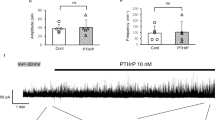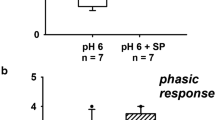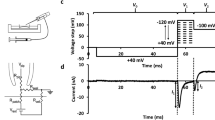Abstract
The effect of loop diuretics at concentrations known to influence cellular water entry coupled to Na-K-Cl co-transport, upon the vacuolation and detubulation following osmotic shock, was investigated in amphibian skeletal muscles. These were exposed to a glycerol-Ringer solution (18 min), an isotonic Ca2+/Mg2+ Ringer solution and cooling. Adding bumetanide (1.0 and 2.0 μM) to these solutions sharply reduced the incidence of detubulation, assessed by abolition or otherwise of action potential after-depolarisations, from 93.9 ± 4.7% (n = 6) to 5.0 ± 1.1% (n = 4: mean ± SEM: 2.0 μM bumetanide). It dramatically reduced the number and fraction of muscle volume occupied by tubular vacuoles, measured using confocal microscopy, from 60.3 ± 4.3% (n = 10) to 9.0 ± 1.1% (n = 35). The incidence of large horseradish peroxidase-lined tubular vacuoles, viewed using electronmicroscopy, similarly was reduced with 2 μM bumetanide in the glycerol-Ringer solution. Bumetanide acted through cellular volume adjustments early in the detubulation protocol. Thus, it exerted its maximum effect when added to the glycerol-Ringer, rather than the Ca2+/Mg2+ Ringer solution. Furthermore, whereas fibre diameters measured using scanning electron microscopy returned to normal during glycerol treatment relative to those of control fibres left in isotonic Ringer, addition of 2.0 μM bumetanide in the glycerol Ringer left markedly smaller fibre diameters. Finally equipotent concentrations of the chemically distinct loop diuretics, furosemide and ethacrynic acid similarly influenced detubulation. These findings implicate Na-K-Cl co-transport in the water entry into muscle fibres that would be expected following introduction of extracellular glycerol. This might then enable the subsequent Na-K-ATPase dependent water extrusion that produces the tubular distension (vacuolation) and detachment (detubulation) following glycerol withdrawal, phenomena also observed in muscular dystrophy.
Similar content being viewed by others
References
Adrian RH (1956) The effect of internal and external potassium concentration on the membrane potential of frog muscle. J Physiol 133: 631–658.
Adrian RH and Peachey LD (1973) Reconstruction of the action potential of frog sartorius muscle. J Physiol 235: 103–131.
Aiton JF, Chipperfield AR, Lamb JF, Ogden P and Simmons NL (1981) Occurrence of passive furosemide-sensitive transmembrane potassium transport in cultured cells. Biophys Biochem Acta 646: 389–396.
Albuquerque EX and Warnick JE (1971) Electrophysiological obser-vations in normal and dystrophic chicken muscles. Science 172:1260–1262.
Amsler K and Kinne R (1986) Photoinactivation of sodium-potassium-chloride cotransport in LLC-PK1/CL4 cells by bumetanide. Am J Physiol 250: 799–806.
Ayettey AS and Navaratnam V (1978) The T-tubule system in the specialized and general myocardium of the rat. J Anat 127: 125–140.
Caputo C (1968) Volume and twitch tension changes in single musclefibres in hypertonic solutions. J Gen Physiol 52: 793–809.
Drewnowska K and Baumgarten CM (1991) Regulation of cellular volume in rabbit ventricular myocytes: bumetanide, chlorothiazide and ouabain. Am J Physiol 255: C122-C131.
Dorup I and Clausen T (1996) Characterisation of bumetanide-sensitive Na and K transport in rat skeletal muscle. Acta Physiologica Scandinavica 158: 119–127.
Dulhunty AF and Gage PW (1973) Differential effects of glycerol treatment on membrane capacity and excitation contraction coupling in skeletal muscle. J Physiol 234: 373–408.
Endo M (1966) Entry of fluorescent dyes into the sarcotubular systemof the frog muscle. J Physiol 185: 224–238.
Eisenberg RS, Howell JN and Vaughan PC (1971) The maintenance ofresting potentials in glycerol-treated muscle fibres. J Physiol 215:95–102.
Franzini-Armstrong C, Heuser JE, Reese TS, Somlyo AP and Somlyo AV (1978) T-tubule swelling in hypertonic solutions: a freeze substitution study. J Physiol 283: 133–140.
Franzini-Armstrong C, Venosa RA and Horowicz P (1973) Morphology and accessibility of the ‘transverse’ tubular system in frog sartorius muscle after glycerol treatment. J Membr Biol 14: 197–212.
Fraser JA, Skepper JN, Hockaday AR and Huang CL-H (1998) The tubular vacuolation process in amphibian skeletal muscle. J Muscle Res Cell Motil 19: 613–629.
Frelin C, Chassandre O and Lazdunski M (1986) Biochemical characterisation of the Na-K-Cl co-transport system in chick cardiac cells. Biochem Biophys Res Commun 134: 326–331.
Gage PW and Eisenberg RS (1969a) Capacitance of the surface andtransverse tubular membrane of frog sartorius muscle fibres. J GenPhysiol 53: 265–278.
Gage PW and Eisenberg RS (1969b) Action potentials, afterpotentials and excitation-contraction coupling in frog sartorius fibers without transverse tubules. J Gen Physiol 53: 298–310.
Gallagher FA and Huang CL-H (1997) Osmotic detubulation in frog muscle arises from a reversible vacuolation process. J Muscle Res Cell Motil 18: 305–322.
Garay RP and Ciccone J (1982) Inhibition of the Na/K co-transport system by cAMP and intracellular Ca2+ in the human erythrocyte. Biochem Biophys Acta 688: 786–792.
Gonzalez-Serratos H, Somlyo AV, McClellan G, Shuman H, Borrero LM and Somlyo AP (1978) Composition of vacuoles and sarco-plasmic reticulum in fatigued muscle: electron probe analysis. Proceedings of the National Academy of Science USA 75: 1329–1333.
Greger R and Pfeiffer P (1985) Ion transport mechanisms in the thickascending loop of Henle in the mammalian nephron. Physiol Rev 65: 760–797.
Greger R, Wittner C, Schlatter E and Di Steffano A (1984)Na-Cl K co-transport in the thick ascending limb of Henle's Loop and mechanisms of action of loop diuretics. Coupled transport in nephron 96–118.
Goodman RH and Gilman JA (1994) The Pharmacological Basis of Theraputics, 9th edn, p. 330.
Haas M and McManus TJ (1985) The effects of norepinephrine on swelling induced potassium transport in duck red blood cells: Evidence against a voltage-regulated decrease under physiological conditions. J Gen Physiol 85: 649–667.
Hoffmann EK, Schmidt M and Dunham P (1986) The number of chloride/cation co-transport sites on Ehrlich ascites cells measured with [3H] bumetanide. Am J Physiol 250: C686-C693.
Hoffmann EK and Simonsen LO (1989) Membrane mechanisms in volume and pH regulation in vertebrate cells. Physiol Rev 69: 315–382.
Howell JN (1969) A lesion of the transverse tubules of skeletal muscle. J Physiol 201: 515–533.
Howell JN and Jenden DJ (1967) T-tubules of skeletal muscle: morphological alterations which interrupt excitation-contraction coupling. Fed Proc 26: 553.
Huang CL-H and Peachey LD (1989) Anatomical distribution of voltage-dependent membrane capacitance in frog skeletal muscle fibres. J Gen Physiol 93: 565–584.
Kohomoto O, Kreuger JA and Barry WH (1990) Activation of furosemide-sensitive K fluxes in myocytes by ouabain and recovery from metabolic inhibition. Am J Physiol 259: H962-H972.
Koutsis G, Philippides A and Huang CL-H (1995) The after-depolarisation in Rana temporaria muscle fibres following osmotic shock. J Muscle Res Cell Motil 16: 519–528.
Krolenko SA (1969) Changes in the T-system of muscle fibres underthe influence of influx and efflux of glycerol. Nature 221: 966–968.
Krolenko SA (1971) Effect of fluxes of sugars and mineral ions on thelight microscopic structure of frog fast muscle fibres. Nature 229: 424–426.
Krolenko SA and Adamyan SY (1996) Effects of membrane transportinhibitors on skeletal muscle vacuolation due to glycerol withdrawal. Tsitologija 38: 751–757.
Krolenko SA, Adamyan SY and Lucy JA (1997) Functional role of vacuolation in the T-system of skeletal muscle. Tsitologija 39: 878–888.
Krolenko SA, Amos WB and Lucy JA (1995) Reversible vacuolation of the transverse tubules of frog skeletal muscle: a confocal fluorescence microscopy study. J Muscle Res Cell Motil 16: 401–411.
Kregenov FM (1971) Osmoregulatory salt transport mechanisms; control of cell volume in anisotonic media. Ann Rev Physiol 43: 493–505.
Lang F, Busch GL, Ritter M, Volkl H, Waldegger S, Gulbins E and Haussinger D (1998) Functional significance of cell volume regulatory mechanisms. Physiol Rev 78: 247–306.
Lannergren J and Westerblad H (1987) Action potential fatigue in single skeletal muscle fibres of Xenopus. Acta Physiol Scand 129: 311–318.
Liedtke CM (1992) The Na-K-Cl co-transporter Ann Rev Physiol 51:143–160.
Libelius R, Jirmanova I, Lundquist I, Thesleff S and Barnard EA (1979) T-tubule endocytosis in dystrophic chicken muscle and its relation to muscle fiber degeneration. Acta Neuropath 48: 31–38.
Malouf NN and Sommer JR (1976) Chicken Dystrophy: The geometryof the Transverse Tubules. Am J Pathology 84: 299–307.
Musch MW and Field M (1989) K-independent NaCl cotransport in bovine tracheal epithelial cells. Am J Physiol 256: C658-C665.
Nakajima S, Nakajima Y and Peachey LD (1973) Speed of repolarization and morphology of glycerol-treated frog muscle fibres. J Physiol 234: 465–480.
Nik-Zainal S, Skepper JN, Hockaday AR and Huang CL-H (1999) Cardiac glycosides inhibit detubulation in amphibian skeletal muscle fibres exposed to osmotic shock. J Muscle Res Cell Motil 20: 45–53.
O'Donnell ME, Brandt JD and Curry FRE (1995) Na-K-Cl co-transport regulates intracellular volume and monolayer permeability of trabecular meshwork cells. Am J Physiol 337: C1067-C1074.
O'Grady SM, Vaandrager AB, DeJonge HR and Field M (1987) Na-K-Cl co-transport in the winter flounder intestine and bovine kidney outer medulla: [3H] bumetanide binding and effects of furosemide analogues. J Gen Physiol 92: 51–63.
Owen NT (1984) Regulation of the Na-K-Cl co-transporter in vascularsmooth muscle. Biochem Biophys Res Commun 512: 500-508.
Padmanabhan N and Huang CL-H (1990) Separation of tubular electrical activity in amphibian skeletal muscle through temperature change. Ex Physiol 75: 721-724.
Panet R, Fixler R, Synder D, Raz S, Atlan H, Eilam Y and Hasin Y (1990) Role of Na-K-Cl transporter in the positive inotropic effect of oubain in cultured myocytes. J Cell Physiol 145: 24-29.
Russell JM (1983) Cation coupled chloride influx in the squid axon: therole of potassium and the stoichiometry of the transport process. J Gen Physiol 81: 909-925.
Vandenberg JI, Rees SA, Wright AR and Powell T (1996) Cell swellingand ion transport pathways in cardiac myocytes. Cardiovasc Res 32: 85-97.
Venosa RA (1991) Hypo-osmotic stimulation of active Na+ transportin frog muscle: Apparent upregulation of Na+ pumps. J MembrBiol 120: 97-104.
Warnock DG, Greger R, Dunham PB, Benjamin MA, Frizzel RA, Field M, Spring KR, Ives HT, Aronson PS and Seifter J (1984) Ion transport processes in apical membranes of epithelia. Fed Proc 43: 2473-2487.
Weibel ER (1979) Stereological Methods. Academic Press, London and NY.
Zachar J, Zacharova D and Adrian RH (1972) Observations on ‘detubulated’ muscle fibres. Nat New Biol 239: 153-155.
Author information
Authors and Affiliations
Rights and permissions
About this article
Cite this article
Khan, K.N., Skepper, J.N., Hockaday, A.R. et al. Loop diuretics inhibit detubulation and vacuolation in amphibian muscle fibres exposed to osmotic shock. J Muscle Res Cell Motil 21, 79–90 (2000). https://doi.org/10.1023/A:1005618720122
Issue Date:
DOI: https://doi.org/10.1023/A:1005618720122




